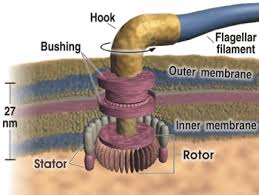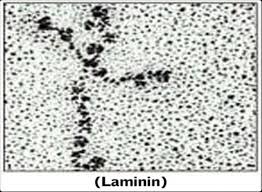Intelligence in Biochemistry
Shrinking down to the size of an atom as you rode Disneyland’s Adventure Thru Inner Space was both scary and exciting as you imagined how far into the microscopic world we could travel. This attraction opened on August 5, 1967 as part of the New Tomorrowland and was every serious science student’s favorite ride. It was the first attraction to utilize Disney’s Omnimover system, but it closed in 1985 moving on to more imaginative rides leaving this one in the archives of nostalgia.
Today we hear about quarks and leptons that are unimaginably smaller than even the atom’s proton. How far will we be able to peer into inner space, how small can we go and what do these microscopic particles teach us? Are we finding clues to chemical operations that exist due to chance random processes, as evolution would teach, or are these discoveries allowing us to glimpse into the creative mind of God?
Richard Dawkins, noted Biologist and Atheist, in his book “The Blind Watchmaker,” said: Biology is the study of complicated things that give the appearance of having been *designed for a *purpose.
Francis Crick, Nobel prize winning scientist for the discovery of the structure of DNA has said: Even though things often give the appearance of being *designed, we must constantly keep in mind that what we see is not designed but rather evolved.
*Notice how evolutionists can’t help but use words like design and purpose. Could it be that things appear designed for a purpose because they really are?
Evidence of Design in Biochemistry:
Evidence #1: Irreducibly complex molecular machines in cells
Michael Behe’s theory of irreducible complexity:
Michael Behe shook the evolutionary scientists’ world when he wrote his book called “Darwins Black Box.” In this book he presented evidence of irreducibly complex microscopic structures in living things that must have come into existence all at once, and not by gradual evolutionary changes. Today there are many scientists that have confirmed Behe’s work and more.
Irreducible complexity:
A single system composed of several well-matched, interacting parts that contribute to the basic function, wherein the removal of any one of the parts causes the system to effectively cease functioning… Any precursor to an irreducibly complex system that is missing a part is, by definition, nonfunctional.
As an example Behe uses the simple illustration of a mousetrap:
If any one of the small parts of a mousetrap is missing then the trap cannot work at all. Because all the parts are required to be there at the same time (they cannot slowly or incrementally be added) the trap by definition is irreducibly complex.
One of the best examples of irreducible complexity is found in the tail (flagellum) of bacteria. Behe demonstrates how the design of the bacterial flagellum mimics that of an outboard motor, a highly manufactured and irreducibly complex structure. This fascinating comparison brings to light the detail involved in the creation of even the smallest microscopic part.
Other examples of things that are irreducibly complex include:
The structure of the eye: Sight could not be possible during a transitional phase of evolution, it all has to be there at the same time sight to happen
The blood clotting factor: If this process came about in slow incremental phases the organism would bleed to death and could never come into being.
The cochlea of the ear: The ability to hear, one of the animal kingdom’s most important factors, would not be available until the evolutionary process had reached this phase.
Evidence #2: The information code in DNA
What is DNA?
- DNA is found in the cells of all living things
- A cell is the basic unit of life and a complicated molecular machine (a tenth of the size of the head of a pin) it is made up of about three billion units of DNA
- DNA contains information encoded on strands that make up our genes—these genes are found on chromosomes located inside the nucleus of the cell
- DNA has coded instructions on how to build and maintain the systems of the body
Where did this code come from? A code implies information. Information can only come from intelligence and intelligence can only come from a mind. Evolution does not have a mechanism for intelligence.
To the skeptic, the proposition that the genetic programmes of higher organisms, consisting of something close to a thousand million bits of information, equivalent to the sequence of letters in a small library of one thousand volumes, containing in encoded form countless thousands of intricate algorithms controlling, specifying and ordering the growth and development of billions and billions of cells into the form of a complex organism, were composed by a purely random process is simply an affront to reason. But to the Darwinist the idea is accepted without a ripple of doubt – the paradigm takes precedence!”
― Michael Denton,
For a deeper look into the problems with evolution watch, “Cross Examining Evolution,” by Dr. Sean McDowell:
Evidence #3: Laminin
To the skeptic laminin is just “a fibrous protein present in the basal lamina of the epithelia,” it is a protein adhesion molecule that helps bind our cells that just happens to be in the shape of a cross! To a Christian who sees God’s signature in our very bodies laminin is a tribute to what the God of the Bible promised to do for us from the very beginning. It is the symbol of what Jesus accomplished in defeat of death and it is the very symbol that helps us remember that we are His children and we have an eternal home with Him. (John 14)
For more on Laminin, and a powerful presentation, watch, “How Great Is Our God,” by Louie Giglio:
For by him all things were created: things in heaven and on earth, visible and invisible, whether thrones or powers or rulers or authorities; all things were created by him and for him. He is before all things, and in him all things hold together. –Colossians 1:16-17
For You formed my inward parts; You wove me in my mother’s womb. I will give thanks to You, for I am fearfully and wonderfully made; Wonderful are Your works, And my soul knows it very well. My frame was not hidden from You, When I was made in secret, And skillfully wrought in the depths of the earth; Your eyes have seen my unformed substance; And in Your book were all written The days that were ordained for me, When as yet there was not one of them. –Psalm 139:13-16
Concluding thought:
If intelligent design is the best answer for the evidence found in search for the cause of the universe and life itself, who then is this designer?
Answer from the Christian worldview:
- The God of the Bible and His nature best fits this description of an intelligent designer
- The cosmological and teleological arguments give us two insights to this designer – one is scientific, the other is personal
- Does the Bible show us a Creator-God that has complete control and order over His creation (science) with a plan and ultimate purpose for His creation (personal)? YES!
For since the creation of the world His invisible attributes, His eternal power and divine nature, have been clearly seen, being understood through what has been made, so that they are without excuse. -Romans 1:20
Reflection:
- Write out one (or more) of the evidence examples for intelligent design in biological life that you would like to remember. Try to put it in your own words so that you can use it in the future as you share your faith with others.
- Prayer focus: The creative design of your own body
Join us next week as we examine more evidence for the existence of God as our Creator!
Please continue to pray for God’s peace and comfort that passes all understanding (Philippians 4:4-7) for Nabeel Qureshi’s family, and the continued ministry of his wife Michelle, especially during the holiday season which can be especially tough at times like these. In God’s will and Jesus’ Name always we pray, Amen.
————————————————————————————————————————————————————
You will not find this material in the public school curriculum even though it is based on solid evidence and grounded in research. It is ironic that following the evidence to where it leads stops at the door of our public schools as they will not let a “Divine footprint” in! Join us as we examine evidence for Christianity and learn how to become a thoughtful defender and ambassador of your faith.
Click into the resource page of this website to view many of the top Christian thinkers and apologists along with some of their work; connecting to these types of resources is essential in your Christian growth.
Please let me know what you think: Give feedback, ask questions or send concerns in the comment section of the blog.
Teri Dugan
TeriDugan@truthfaithandreason.com
1 Peter 3:15










Sorry, comments are closed for this post.